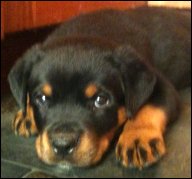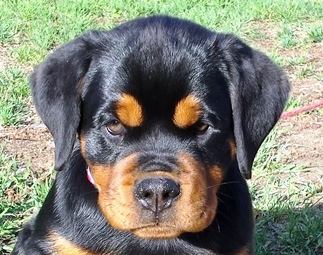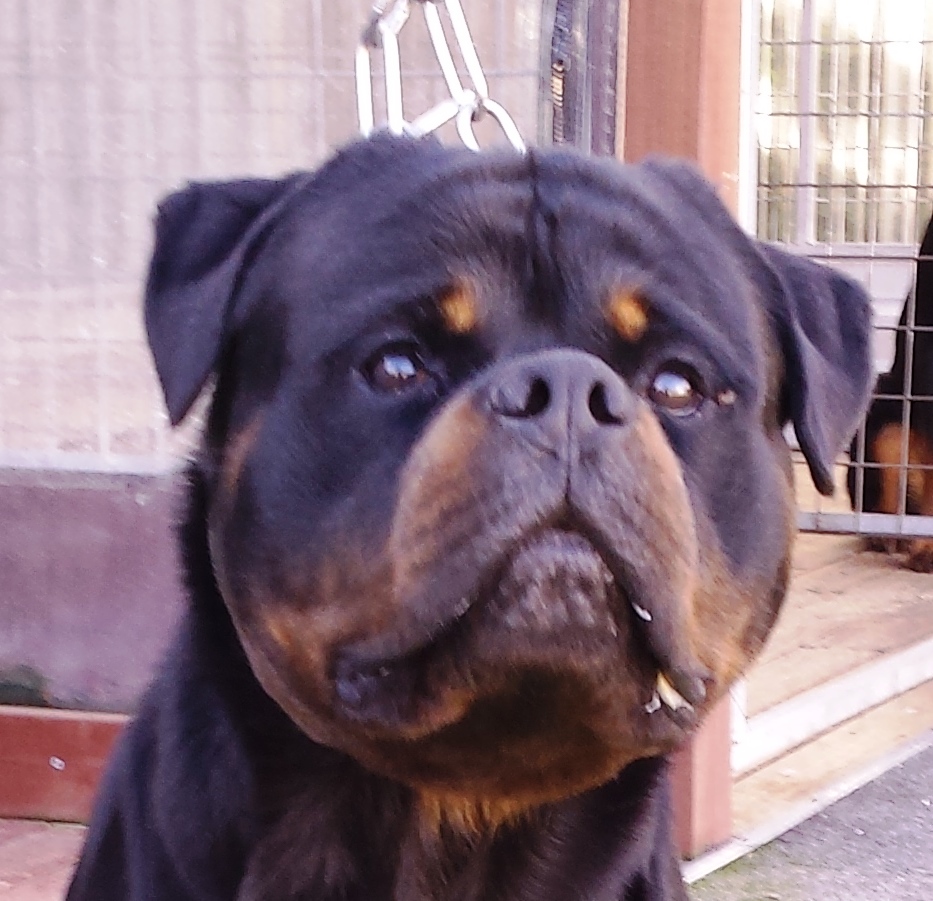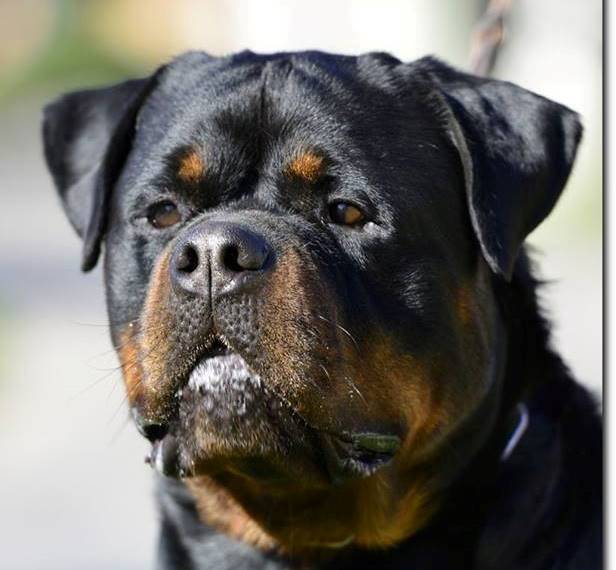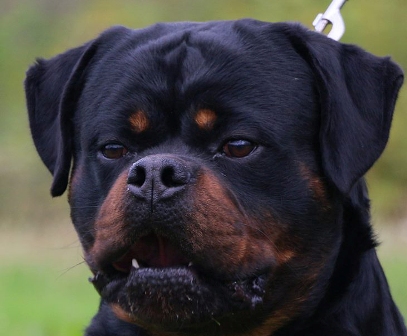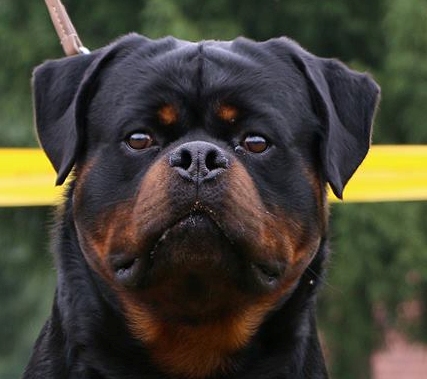Article by Nash from Animal Muscle Release Therapy
I have recently been getting a few young dogs coming in for AMRT sessions for arthritic changes and joint pain. So, I decided to do a newsletter ‘series’ for dogs that will include exercises and care from the young dog through to the older dog. The purpose of the suggested exercises and care will be to support preventative care for joints while ensuring your dog stays fit, no matter their age.
“Exercise not only builds puppies’ bodies, it helps build their minds” is the motto that has been ingrained in us, though exercise that’s not appropriate for a Rottweiler puppy’s age and development can cause significant and irreversible damage.
An exercise that resulted in a simple sprain for an adult dog could leave a puppy with a misshapen or shortened limb, so the subject of age-appropriate exercise is one that should be taken seriously.
Understanding Rottweiler Puppy growth
The first concept to understand when it comes to puppy exercise is “growth plates.” Growth plates are soft areas that sit at the ends of the long bones in puppies and young dogs. They contain rapidly dividing cells that allow bones to become longer until the end of puberty.
Growth plates gradually thin as hormonal changes approaching puberty signal the growth plates to close. In puppies, this closure is normally completed by approximately 18 months old.
Until the growth plates close, they’re soft and vulnerable to injury.
After sexual maturity, the growth plates calcify and the rapid cell division ends. The growth plate becomes a stable, inactive part of the bone, now known as an epiphyseal line.
Here at Meisterhunde we do not recommend you de sex your pup unless there is a serious medical condition or emergency. Your vet will say otherwise, why, remember this is how vets make their money, by de sexing and over vaccinating our pets.
So do not fall for the scaremonger tactics some vets use. Do you own research, lots of supporting data out there on this subject.
A study published in the UN National Library of Medicine found dogs spayed and neutered at less than a year of age were significantly taller than those de-sexed after age 1.
Furthermore, the bones of pups spayed and neutered before puberty continue to grow. Dogs spayed or neutered at a younger age often have longer limbs, lighter bone structure, narrow chests and narrow skulls. This results in altered body proportions of certain bones relative to others. But, it isn’t just a cosmetic issue.
This disproportion often results in increased stress on ligaments, which can later easily cause injury. Another study published in the UN National Library of Medicine found that dogs spayed or neutered before 5 1/2 months of age were much more likely to develop hip dysplasia than those spayed or neutered after.
Also, dogs spayed or neutered younger than 24 weeks were more likely to develop infectious diseases than dogs who were spayed or neutered at ages older than 24 weeks. As for female dogs, there has been an increase in urinary incontinence in those spayed too early.
Early de-sexing can also have unwanted behavioural effects. A further study published in the National Library of Medicine showed that dogs neutered before 5 1/2 months of age had an increased incidence of noise phobias and unwanted sexual behaviours. Ligament and joint issues and other health matters are increased by 78%.
Also, recent research by the American Kennel Club Canine Health Foundation found that when females were spayed too young, they were more likely to develop fearful behaviours while their male counterparts were more likely to show aggression.
A dog’s bones are held together with muscles, tendons, and ligaments – soft tissue. In an adult dog, if a joint experiences a stress such as bending the wrong way or rotating too much, the bones will hold firm and a soft tissue will be pulled, resulting in a sprain.
In a puppy, however, his muscles, ligaments and tendons are stronger than his growth plates, so instead of a simple sprain, his growth plate is liable to be injured – the puppy’s own soft tissue can pull apart his growth plate.
Why this matters so much is that, unlike a sprain, injuries to the growth plate may not heal properly or not heal in time for the puppy to grow up straight and strong. Injury to a growth plate can result in a misshapen or shortened limb which, in turn, can create an incorrect angle to a joint which can make the puppy more prone to yet more injuries when he grows up.
Puppies have soft bones
In addition to having soft growth plates at the end of long bones, a puppy’s bones in general are “softer.” Dogs, like people, don’t reach their maximum bone density until after puberty.
Spiral fractures of the tibia (lower leg bone) are very common in puppies – 50% of all fractures occur in puppies under 1 year of age. A spiral fracture is where the bottom half of the bone twists in one direction and the top half twists in the other.
This kind of juvenile injury is known as “Toddler Fracture” in humans, and it’s thought to be caused by the fact that the outside, fibrous layer of the bone (periosteum) is relatively strong in relation to the elastic bone inside. So any exercise that puts torque on (twists) a bone puts the puppy at risk for a fracture.
Puppies don’t have the cardiovascular system for endurance. Furthermore, until they mature, they’re probably not able to build much endurance no matter how much they exercise.
In human children, sustained exercise only increases aerobic capacity by up to 10%. In adults, that kind of exercise can increase aerobic capacity by up to 30%. Long walks and exercise sessions increase risk of injury and yield few benefits for puppies, so endurance training is better left until the puppies have grown up.
Puppies naturally exercise in small bursts of activity, not sustained walks.
Correct Exercise increases Bone Density
After reading about growth plates and toddler fractures, you may find yourself not allowing your puppy to move, let alone run and play. Relax! Not only is appropriate exercise not dangerous for your puppy, exercise has been shown to increase bone density in children. Furthermore, those children who exercised were a whopping 50% less likely to fracture a bone. There’s every reason to believe the same holds true for dogs, so appropriate exercise is key to building strong bones in your puppy and preventing adult fractures. So let’s talk about guidelines for puppy exercise.
Exploring low rock walls and gardens at their own pace is great mental and physical exercise for puppies.
Guidelines for Puppy Exercises
Self-directed play is an overriding rule for any puppy under 18 months old. The majority of his exercise should be free play, exploring, roaming around. If he shows any fatigue, flops down, refuses to walk, you should listen to him and let him rest.
Do not underestimate the value of a good digging session. Consider digging up a soft patch in a corner of your yard and burying “doggy treasures” in it – great natural exercise for your puppy!
‘No’ to repetition exercises
Probably the biggest cause of growth plate and soft tissue injury is repetitive exercise with a young puppy. So, until they are about 18 months old, long hikes and walks are out and lots of free-play sessions are in.
Sniffing and Strolling great for pups
While long hikes are out, strolling around in the backyard with you is great. If no backyard, short, rambling walks are great. Let your puppy sniff, explore and take it at his own pace. You can use short training sessions in your walks to work on heeling/loose leash walking, but the majority of the time should be at your puppy’s own pace and discretion.
If hiking, you could bring your puppy along – great socialization for puppies under 12 weeks old & older puppies. But just like a small child on a walk, be prepared to carry your puppy a good portion of the way. If you’re jogging or walking on a manicured trail or paved park road, consider investing in a puppy stroller to put your pup in for most of the walk.
Soft Landings
Jumping of beds and couches are major causes of spiral fractures in puppies – we are constantly on guard until our puppies reach two years old and keep them off furniture and beds unless we’re there to help them off. Use heavy carpet pads and carpets around all furniture and beds to cushion impact, should a young (or old) dog slip by and get up on a high piece of furniture.
You can start training in agility but no jumping higher than wrist height until 6 months old, no jumping higher than elbow height until 18 months old.
Stairs not great for young hips
A study of 500 Newfoundland, Labrador, and Leonberger puppies found that puppies who climbed flights of stairs daily before they were 3 months of age had an increased risk of developing hip dysplasia. Although these breeds were selected for the study because of their relatively high incidence of hip dysplasia, the study seems to indicate that stairs represent a strain on any puppy’s joints, so consider ramps or carrying your puppy down stairs if possible. Although climbing flights of stairs on a daily basis represents an inappropriate strain on puppy joints, doing one or two not-too-steep steps with a non-slip surface would not represent any risk to the puppy and may be a nice body awareness, coordination exercise.
Interestingly, the same study found that off-leash, self-directed exercise on gently rolling, varied, and moderately soft ground for puppies under 3 months old decreased the risk of developing hip dysplasia. And it’s important to get that exercise in early! Free play after 12 weeks old, while certainly beneficial in general, was not shown to decrease the risk of hip dysplasia in the study. So, once again, self-directed play in your backyard or garden is the best exercise for young puppies.
Ground only toys and playing nice
A puppy chasing a toy will not stop until they are literally on top of the toy, causing both heavy impact and twisting on the bones and soft tissue. Roll balls or drag toys on the ground for all puppies. Tug toys should be held low and steady – don’t pull up or back on your puppy’s neck!
Puppy necks are delicate! Hold toys low & allow the puppy to pull instead of you tugging on the toy.
Have fun with your Rottweiler puppy, but PLEASE play it safe.


